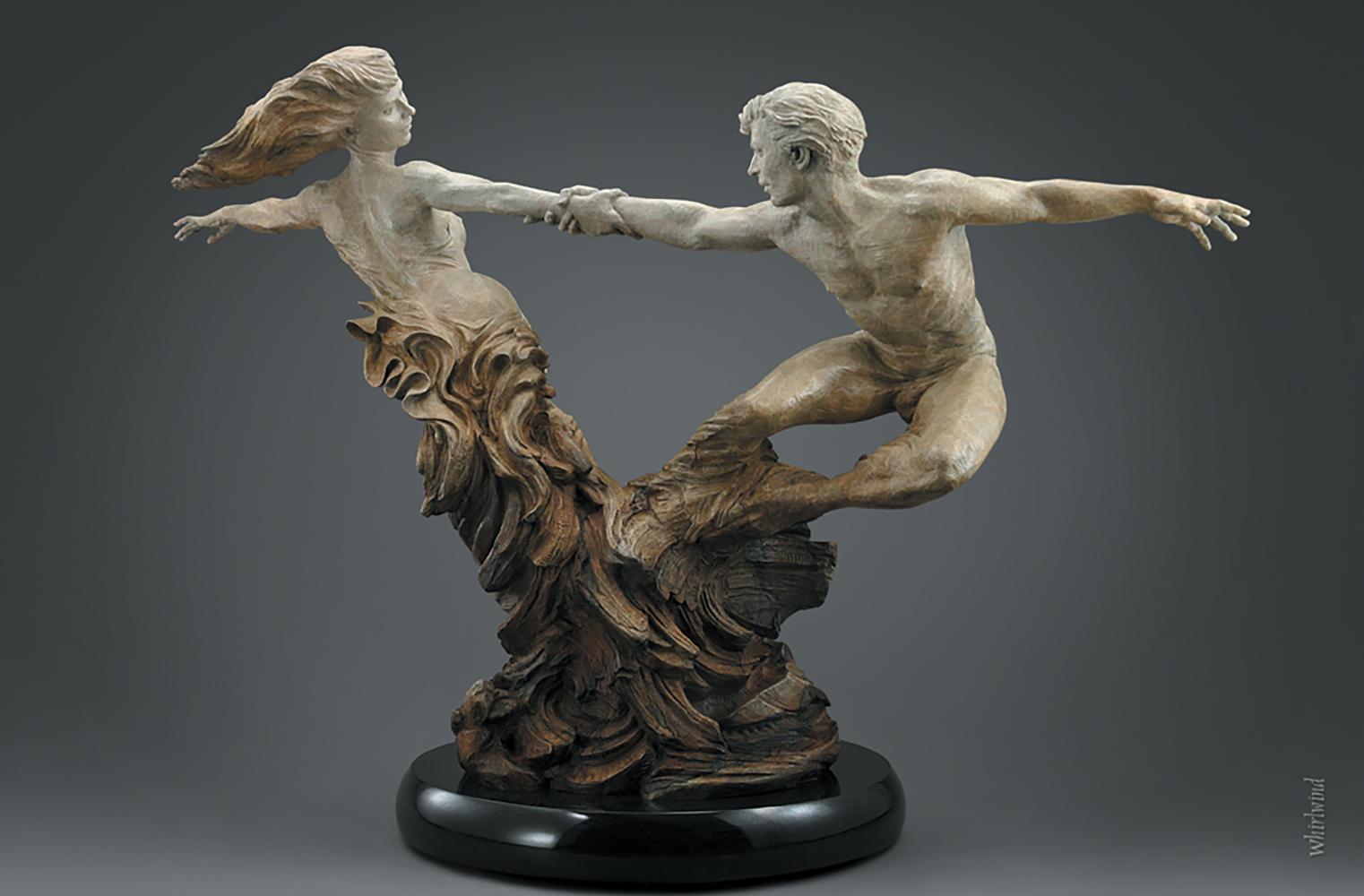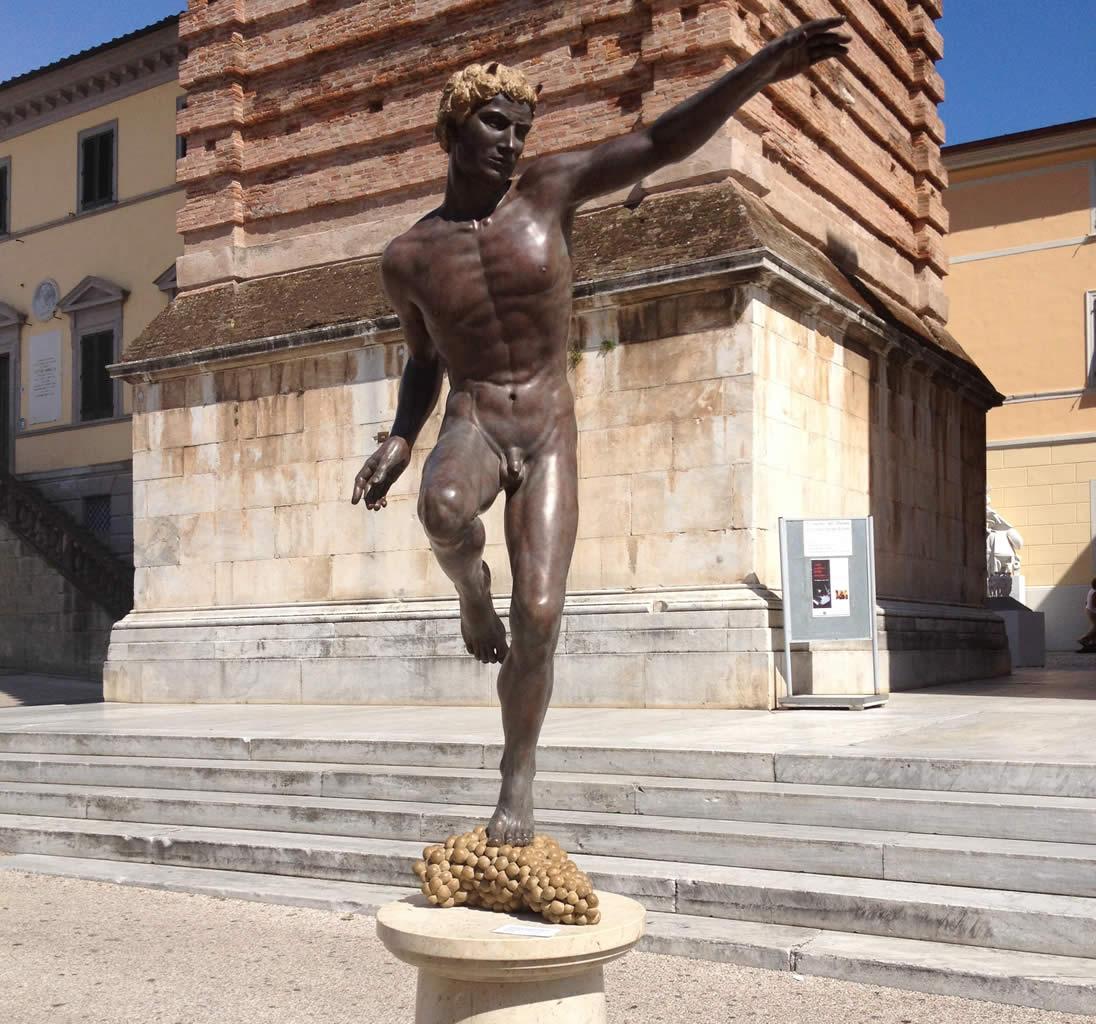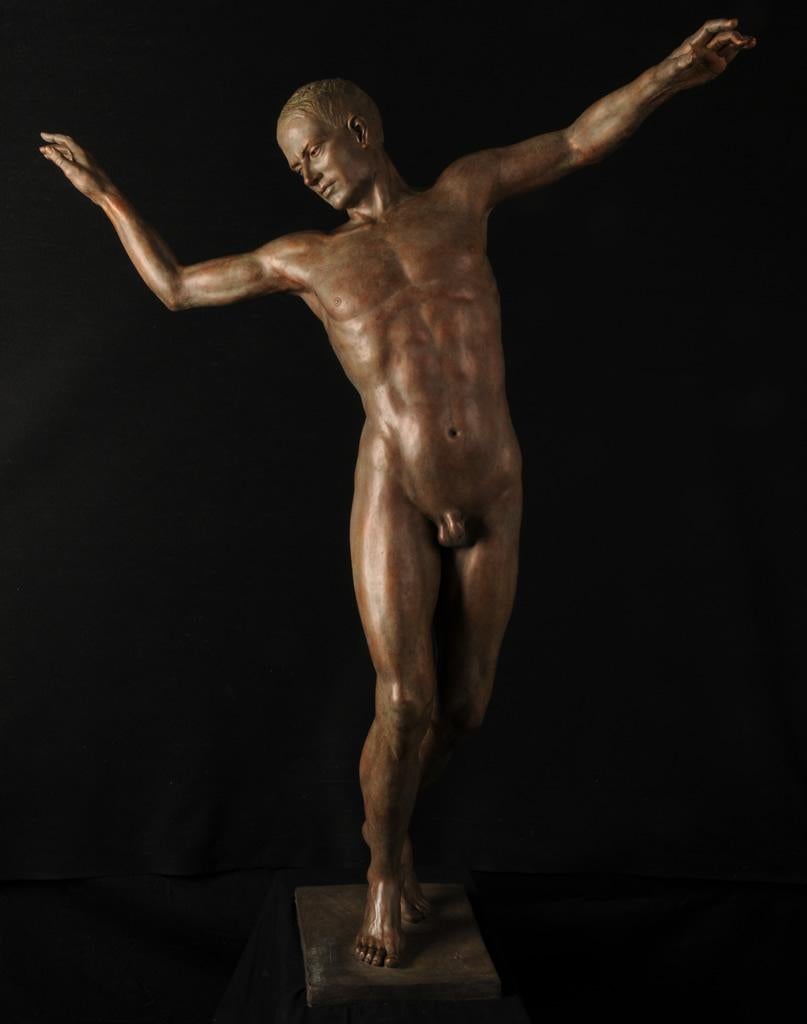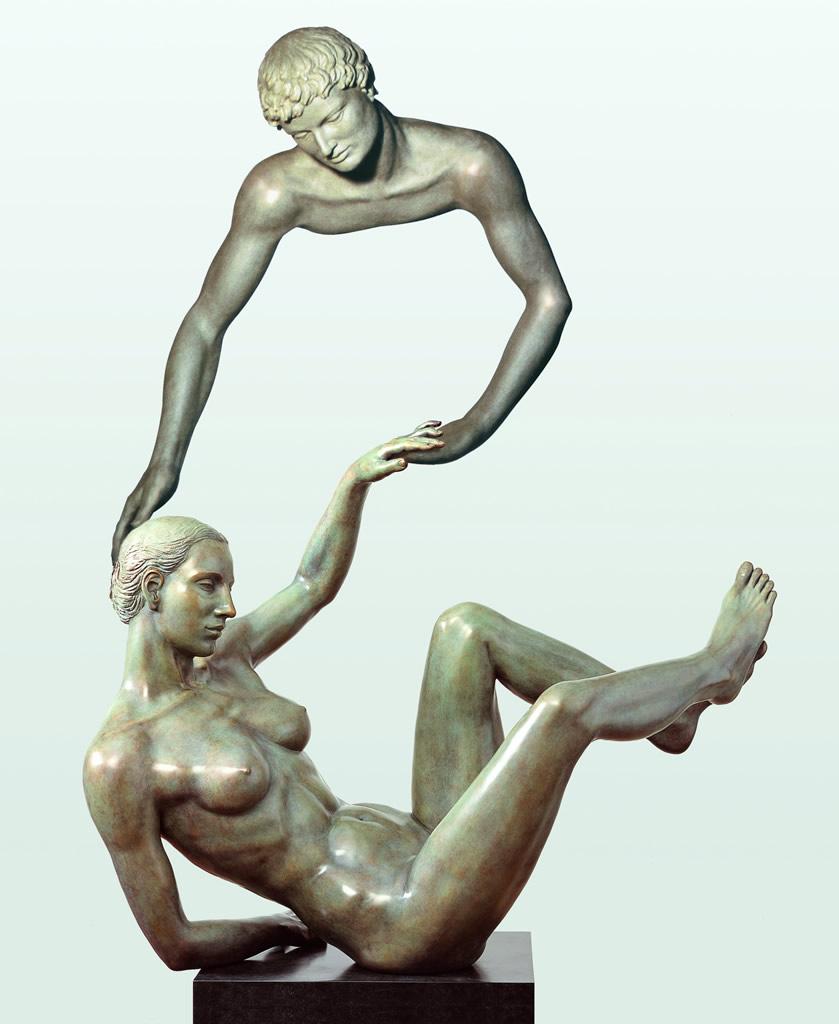Items Similar to Jean Garnier, L'Enfer des Luxurieux, The Hell of the Luxurious, Erotic Relief.
Want more images or videos?
Request additional images or videos from the seller
1 of 11
Jean-François Garnier Jean Garnier, L'Enfer des Luxurieux, The Hell of the Luxurious, Erotic Relief.c.1859-1864
c.1859-1864
About the Item
A rare round relief cast, elaborate chiseled bronze/copper with brown patina by Jean François Marie Garnier (1820-1895). Cast c.1859-1864. Not signed. The motif is taken from Dantes, The Divine Comedy´s, first part, Inferno and the second circle, called "L'Enfer des Luxurieux", in english "The Hell of the Luxurious". See identical relief, signed Jean Garnier, in Musée d'Orsay in Paris, inventory no. OA 3666, also belonging to the Louvre collections. Another cast of the relief is part of the Museum of Lyon collections. Framed in a 19th century stained oak frame. The dimensions are the exact as the one in Musée d'Orsay. Later copies, of which a few are known, usually have a larger diameter and lesser quality in casting etc.
The relief, L'Enfer des Luxurieux, in the Musée d'Orsay collection, was exhibited 2023-2024 during the exhibition: Louis Janmot, "The Poem of the Soul", in french 'Le Poème de l’âme'.
From the introduction text of the exhibition:
"The Poem of the Soul" suit was begun in Rome in 1835 and completed in 1881, The Poem of the Soul is the crowning achievement of the Lyonese artist Louis Janmot (1814-1892), a pictorial and literary work all in one. In 34 compositions accompanied by a long poem, it illustrates a soul’s initiatory journey on Earth.
Garnier and Janmot were both from Lyon and they probably knew each other and Garnier was likely inspired by Janmot´s work. Jean Francois Marie Garnier was born in Lyon and died in Paris. He is sometimes mixed up with another artist, with a very similar name, Alfred Jean Garnier (1848-1921).
During the 19th century, particularly with romanticism, then symbolism, the representation of the soul took on considerable importance. Artists respond in varied ways to the same iconographic problem: how to represent an immaterial entity, distinct from the body and having an existence beyond death? In turn, the soul takes the form of a winged female figure, an allegory of purity and spirituality, or materializes in the form of a shadow or a flow escaping from the body.
The second circle, in Dantes Inferno, depicted in this relief shows the fate of the damned souls, also called the “lustful”. The souls in this circle is to be swept away by relentless winds. All people guilty of the sin of lust are whirled round and round in an unending storm. The storm, represents irresistible passion. Among those being blown about are mythic and historical queens. The sin of these souls is that of having submitted reason to their carnal appetites, of having committed the sin of the flesh. Among them are the souls of Semiramis, Cleopatra, Dido, Helen of Troy, Paris, Tristan, Francesca da Rimini and Paolo Malatesta.
The two center figures embracing each other in the relief depicts Francesca da Rimini and Paolo Malatesta.
The Divine Comedy is a literary masterpiece written by Dante Alighieri (1265-1321) in the first half of the 14th century. The Comedy symbolises humankind’s journey for redemption through the three afterlife kingdoms: Inferno, Purgatory and Paradise.
While Purgatory and Paradise are embedded with theological and philosophical considerations, Inferno is a testimony of the political corruption at that time. Italy was the battlefield for the political fights between the Pope and the Emperor. It was one of the most merciless ‘Games of Thrones’ in medieval history.
Dante tells the story of many political and religious figures, who – blinded by political ambitious – committed murders, cannibalism, treason, and suicide all in the name of ‘worldly power’.
In a sense, Dante’s Inferno is the first attempt to challenge the dominant social imaginary through storytelling. Dante is aware that unless humanity achieves spiritual redemption, his world will be forever lost in the wood of sins and corruption.
Each circle that constitutes Hell introduces characters that embed a specific characteristic of the dominant imaginary that needs to be criticized. The only exception can be found in Canto V (chapter V), in which – only on this occasion- Dante took pity of two condemns: Paolo and Francesca di Rimini.
Canto V is the testimony of Dante’s powerful narrative technique that triggers empathy in the readers. Even though Paolo and Francesca committed adultery and therefore had to be put in the circle of the lustful, their love story is so moving that the readers conceive them as the innocent victims of a dreadful/unjust fate.
Francesca di Rimini was a beautiful noble girl – destined to become a nun – but she was kidnapped and forced to marry the violent Gianciotto Malatesta, Paolo’s older brother. While living together, Paolo and Francesca fell in love. Unfortunately, the brother discovered their affair and killed the two lovers, condemning his brother and his wife to an eternity in Hell. Nevertheless, Paolo and Francesca’ sin becomes secondary to the readers because what really matters is that their life was brutally interrupted. Paolo and Francesca can be finally together and free to live their love but they have to go through eternal suffering.
In this Canto, Dante uncommonly employs a sweet, romantic and poetic language. The words are characterized by a slow rhythm that creates emphasis and pathos to the story. The readers are capable of creating an emotional connection with the characters and cannot help identifying themselves with the pain and sorrow these two star-crossed lovers have to go through every day to be together.
Paolo and Francesca’s story is an outstanding example of the emotional power of language that may open doors to change and better justice.
- Creator:Jean-François Garnier (1820 - 1895, French)
- Creation Year:c.1859-1864
- Dimensions:Height: 1.19 in (3 cm)Diameter: 20.87 in (53 cm)
- Medium:
- Movement & Style:Symbolist
- Period:
- Condition:There are a few breakage places on the outer rim of the cast, one barely visible by the frame edge.
- Gallery Location:Stockholm, SE
- Reference Number:1stDibs: LU2608213929842
About the Seller
5.0
Gold Seller
These expertly vetted sellers are highly rated and consistently exceed customer expectations.
1stDibs seller since 2023
6 sales on 1stDibs
Typical response time: 2 hours
- ShippingRetrieving quote...Ships From: Stockholm, Sweden
- Return PolicyA return for this item may be initiated within 14 days of delivery.
More From This SellerView All
- Niels Holm, 19th Century Bronze sculpture of Mother Elephant with Baby ElephantLocated in Stockholm, SEA fine patinated bronze sculpture of a mother elephant with her baby elephant by Niels Holm (1860-1933). Signed NIELS HOLM, ELEPHASINDICUS, ENDANGER. Also signed L. RASMUSSEN, KOBENH...Category
Late 19th Century Naturalistic Figurative Sculptures
MaterialsMarble, Bronze
- 16th Century Cameo Pendant of Christ the Redeemer in a Gilt Bronze FrameLocated in Stockholm, SEA finely carved 16th or early 17th century large hard stone pendant cameo of Christ the Redeemer in profile. Set in period a gilt bronze frame. Possibly Italian. The profile view of...Category
16th Century Italian School Figurative Sculptures
MaterialsPrecious Stone
- Christian Berg, Pair of Goosander Birds On Ice Floes.Located in Stockholm, SEA female and male Goosander bird on ice floes. In the center of the painting there is a smaller opening in the ice covered waters. This painting, by Christian Berg (1893-1976) is quite interesting and unusual for his works. It is signed "Ch. Berg" and dated 1918. Berg is mostly famous for his sculptures which was to become his signum works later in his life. He is known primarily for his abstract artworks. He was educated at the Technical School and Althin's painting school in Stockholm 1911–1914. In the years 1914–1917 he studied at the Royal Academy of Fine Arts and started with animal painting in the spirit of Bruno Liljefors. Our painting is from this period just after he finished his studies at the Royal Academy of Fine Arts. In 1921, he studied in Berlin and Dresden which was followed by a trip to Egypt in 1925. In the same year he moved to Paris and had a studio on rue Guénégaud. He studied with André Lhote and his interest in cubism was awakened. Made sketch drawings at the free academies Colarossi and La Grande Chaumière and in 1927 he met the Swedish artist Erik Olson...Category
1910s Naturalistic Animal Paintings
MaterialsCanvas, Oil
- Sunset in an Oriental Landscape By The Sea.Located in Stockholm, SEA fine painting depicting an oriental shoreline sunset with red skies and two oriental women walking towards their village by the beach and sea. Oil on cardboard by an unidentified a...Category
Late 19th Century Naturalistic Landscape Paintings
MaterialsOil, Cardboard
- Emil Orth, South Funen Archipelago with Two People Fishing.Located in Stockholm, SEA fine oil painting by Emil Cordius Heinrich Orth (1833-1919) depicting a woman and a man in a rowing boat near the shore laying out fishing nets on a sunny summer day. It is signed ...Category
1860s Naturalistic Landscape Paintings
MaterialsCanvas, Oil
- Wilhelm Behm, Fall Landscape, with Lake and Hilly Nature SurroundingsLocated in Stockholm, SEA beautiful Swedish autumn landscape on a sunny day with a lake and a large birch tree in focus surrounded by a hilly landscape and vegetation painted by Wilhelm Emanuel Behm (1859-1...Category
1880s Realist Landscape Paintings
MaterialsCanvas, Oil
You May Also Like
- "Whirlwind", Martin Eichinger, Figurative, Bronze, Romantic, 54x84x72 in.By Martin EichingerLocated in Dallas, TXThe dynamic nature of this ecstatic pirouette must be experienced from all sides. Whirlwind examines the forces of attraction and separation in a relationship. The couple’s solid bon...Category
Early 2000s Realist Figurative Sculptures
MaterialsBronze
- Figura DistesaBy Franco FranchiLocated in Miami, FLFranco Mauro Franchi was born in Castiglioncello (Livorno) on 9 October 1951. He completed his artistic studies at the Lucca State Institute of Art and the Academy of Fine Arts in Fl...Category
Late 20th Century Contemporary Figurative Sculptures
MaterialsBronze
- Dionysisch Big Bronze Sculpture Mythology Classical Contemporary ArtBy Margot HomanLocated in Utrecht, NLDionysisch Big Bronze Sculpture Mythology Classical Contemporary Art The sculptures of Margot Homan (1956, Oss, NL) show a perfect command of the...Category
21st Century and Contemporary Contemporary Nude Sculptures
MaterialsBronze
- Last Heroic Season Bronze Sculpture Classic Contemporary MythologyBy Margot HomanLocated in Utrecht, NLLast Heroic Season Bronze Sculpture Classic Contemporary Mythology The sculptures of Margot Homan (1956, Oss, the Netherlands) show a perfect command of the old craft of modelling a...Category
21st Century and Contemporary Contemporary Nude Sculptures
MaterialsBronze
- Danse Mystique Dance Mystic Bronze Sculpture Classical ContemporaryBy Margot HomanLocated in Utrecht, NLDanse Mystique Dance Mystic Bronze Sculpture Classical Contemporary The sculptures of Margot Homan (1956, Oss, the Netherlands) show a perfect command of the old craft of modelling ...Category
21st Century and Contemporary Contemporary Figurative Sculptures
MaterialsBronze
- De Gave The Gift Big Bronze Sculpture Classical Contemporary MythologyBy Margot HomanLocated in Utrecht, NLDe Gave The Gift Bronze Sculpture Classical Contemporary Mythology The sculptures of Margot Homan (1956, Oss, the Netherlands) show a perfect command of t...Category
21st Century and Contemporary Contemporary Figurative Sculptures
MaterialsBronze




